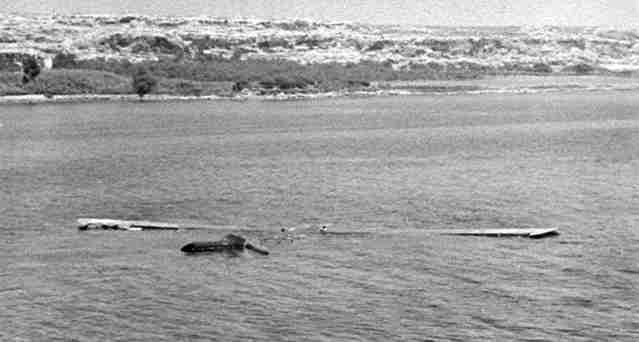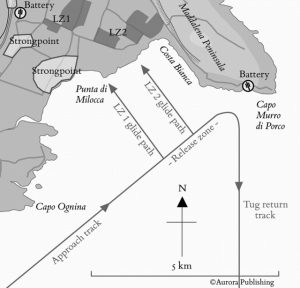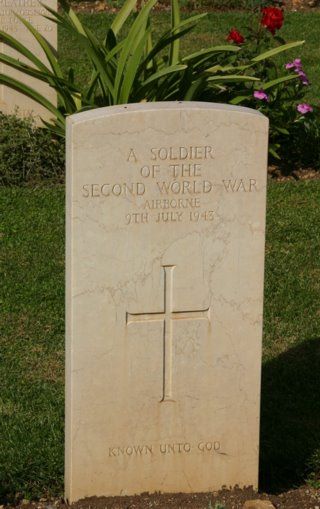Waco glider 70 landed in the sea off Sicily. So did the other two gliders full of medical men attached to 1 Border Regiment in Operation Ladbroke. This was a disaster not just for the medics, but also the men they were supposed to care for.

Glider: CG-4A Waco 70
Glider carrying: Section of 181 Field Ambulance attached to 1 Border Regiment.
Manifest
.(a) Personnel (i) Anaesthetist (1)
. (ii) L/Cpl. Nursing Orderly (2)
. (iii) Private Nursing Orderly, Clerk (3)
. (iv) L/Cpl. – 5 Nursing Orderlies –
. Stretcher bearers (4 – 9)
. (v) 2 Stretcher bearers (with
. different loads from (iv) (10-11)
. (vi) 2 Glider Pilots
.Total 1 Officer: 10 O.Rs. 2 Glider-Pilots
.(b) Transport – (i) Handcart
. (ii) 3 Airborne bicycles
Each man carried a .38 revolver, and two Sten guns were also carried in the glider, presumably for use by the glider pilots.
RAMC Personnel:
Capt. Grahame-Jones
L/Cpl Vincent, H.
L/Cpl Caddick, H.
Pte Cook, R.G.E.
Pte Anderson, J.A.
Pte Phillips, G.
Pte Churm, J.
Pte Oldfield, J.
Pte Kennedy, P.
Pte Cheeseman, R.J.
Pte Smith, H.
USAAF Tug Pilot’s Report
Tug: C-47, 41-18445, 8 Troop Carrier Squadron, 62 Troop Carrier Group, 51 Troop Carrier Wing USAAF.
Takeoff: Between 19:05 and 19:22, from Airstrip C, El Djem No. 2, Tunisia. Priority 24.
Tugs returned: Between 00:38 and 04:15, except one landed at Sfax.Pilot: 1st Lt John A Walker, attached to the 8th TCS from the 7th TCS.
The pilots of 62 TCG must have submitted individual reports at debriefing, but if these were recorded, the document does not seem to have survived. A group report stated:
“Gliders released 2 – 5 minutes late owing to excessive wind. 4 gliders reported released early, but pilots consider they should have reached L.Z.”
Glider Pilot’s Report
Glider allotted Landing Zone: LZ 2.
Glider pilots: Sgt Dilnutt (GPR) & F/O Birdewick (USAAF).
 “When approx off the twin headlands flak came up from there & CAPE MURRO DI PORCO. The tug A/C immediately made a 180° right hand turn & headed East away from land. Tug A/C then ordered release by signal when at 1400 ft. After release glider glided at 75-80 m.p.h. in direction of nearest land, but was unable to reach it & came down in sea approx 4 miles off CAPE MURRO DI PORCO. Glider pilot was unable to recognise any point on land as tug flew Eastwards out to sea prior to release.”
“When approx off the twin headlands flak came up from there & CAPE MURRO DI PORCO. The tug A/C immediately made a 180° right hand turn & headed East away from land. Tug A/C then ordered release by signal when at 1400 ft. After release glider glided at 75-80 m.p.h. in direction of nearest land, but was unable to reach it & came down in sea approx 4 miles off CAPE MURRO DI PORCO. Glider pilot was unable to recognise any point on land as tug flew Eastwards out to sea prior to release.”
The “twin headlands” seem to be the two points north of Capo Ognina.
The claim that the tug executed a U-turn (180 degrees) towards the east seems to be a mistake, as to do that the tug would have to have been flying due west, when it should have been flying north-east. It seems probable the GP meant 90 degrees, with the tug ending up flying south-east, directly away from land and avoiding Cape Murro di Porco.
The records of 1 Airborne Division show that the US glider pilot was called Birdewick. In fact his name was Arnold Bordewich. A pre-Sicily American newspaper story about GPs training in the US reported that “Arnie always wore a cheeky grin”.
Glider 70 Lands in the Sea
Six Waco gliders out of the 135 flying to Sicily on the night of 9 July 1943 were allotted to 181 Air Landing Field Ambulance (22, 26, 30, 62, 66, 70). Three (22, 26, 30) were headed to LZ1 with the gliders of the 2 South Staffords, who were to clear strongpoints on the routes heading towards the Ponte Grande bridge, which in turn had been seized by a separate coup-de-main party. The medics were to set up a dressing station near the bridge. The other three gliders (62, 66, 70) were headed to LZ2 with the gliders of 1 Border Regiment, who were to cross the bridge and capture the outskirts of Syracuse.
Each trio of gliders had one carrying a jeep (22, 66) designed to act as an ambulance, and another (30, 70) carrying a dozen or so men with a handcart full of medical supplies (Glider 70 was one of these). The third glider with the Borderers (62) carried a stretcher trailer for use with a jeep. Finally, the third glider with the Staffords (26) carried a surgical team, under Captain Guy Rigby-Jones, which was the only glider of the six to reach land.
The five medical gliders that landed in the sea were among about 70 Wacos that did so. There were many reasons for this, and the consequences in pointless loss of life were disastrous, but essentially the gliders were released too low or too far from shore to be able to reach land. As a result, there were not enough men to complete all the Air Landing Brigade’s missions – Syracuse was not taken, strongpoints and batteries remained intact, and finally the men on the Ponte Grande bridge were pushed off it by the Italians.
The lack of medical men and ambulances meant that many wounded were not collected for a day or two. The problem was compounded by the fact that the gliders were widely scattered (few reaching the LZs), and many GPs had their legs broken when their Wacos hit one of the many stone walls favoured by Sicilian farmers. In the days before penicillin, such injuries, if unattended, could result in gangrene and death.
Paradoxically, as one senior medical officer observed, the number of gliders that landed in the sea reduced the number of wounded on land that the greatly reduced medical resources had to care for. His grim point was that the medical men that did arrive worked wonders, but with many more wounded, it could have been a medical disaster. It was also lucky that the advancing seaborne forces could loan ambulances, and that Italian ambulances were captured.
In the case of Glider 70, the British glider pilot and six RAMC men survived and were picked up by HMS Beaufort, a destroyer on anti-submarine patrol near the cape. Beaufort had spotted gliders in the water the night before, but she did not stop until the sun was well up, some nine hours later. Many glider men must have drowned because their potential rescuers had higher priorities in the brutal business of war.
The officer ended up on another warship, where he acted in his role as anaesthetist, returning to the airborne base in Tunisia on the 12th. The other survivors were transferred from Beaufort to HMS Sutlej and taken to Malta, where they joined many other glider men who had been rescued from the sea.
The Missing from Glider 70
That left five RAMC men and one US glider pilot unaccounted for. After the battle, enormous efforts were made to find out what had happened to the missing men. What follows is an account by Caddick, submitted as part of the investigation:

“Our glider crashed into the sea some four or five miles from the shore. We released the glider doors and every occupant of the glider was able to get out. My first impulse was to get away from the wreckage, but when I realised that it was still afloat, I swam back and climbed on to it. We then ascertained how many men were safely aboard the wreck, and the above men were missing.
“The glider pilot then informed us that his American co-pilot, together with three of our men had decided to attempt to reach the shore. After being in the sea for about half an hour, we heard three people crying for help. Two of the voices were recognised as Pte. Smith’s and Pte. Kennedy’s. We shouted and flashed a torch but they were unable to reach us owing to the roughness of the sea. They continued to cry for help, but then we heard a choking noise, and the cries ceased.
“Nothing at all was seen of Pte. Cheeseman after we had all scrambled out of the glider. But the three men who followed the pilot must have been Ptes. Churm, Oldfield and Kennedy. The latter evidently changed his mind about trying to reach the shore and attempted to get back to the glider. The third voice we heard and were unable to recognise may have been Pte. Cheeseman, but it is extremely unlikely, as he was a non-swimmer, and no one in the glider had time to fully inflate his life-belt. It is more than likely that it was either Churm or Oldfield also trying to rejoin the glider. Therefore it appears that Ptes. Smith H., Kennedy and Cheeseman were drowned possibly, whilst the happenings to Ptes. Churm and Oldfield are uncertain.”
Vincent and Anderson were interviewed nearly a year later, and their account was summarised:
“The following men were not seen after the glider hit the water :
Pte CHURM J.
Pte OLDFIELD J.
Pte SMITH H.
Pte CHEESEMAN R.
Pte KENNEDY P.
American Bomber pilot acting as co-pilot.
All men were definitely out of the glider before it settled down in the water. L cpl VINCENT was the last to leave the glider. They do not know the names of the pilots.”
Some bodies of drowned men floated into the shore for days after the invasion, and were presumably ultimately buried in the Commonwealth War Cemetery at Syracuse. Many men, however, were never seen again, and they are remembered on the memorial at Cassino.
For other in-depth stories about individual gliders in Operation Ladbroke, click here.

Hello,
My name is Robin Hollamby, I am Vice Chairman, Magazine and Website Editor of the Italy Star Association 1943-1945. I was alerted to this account and your website by Tim Smith, a relation of Private Horace Smith, one of those posted missing after the crash.
Would it be possible for me to put his fascinating piece on our website and in our members magazine? It would of course be credited to you and your website address would appear with the article?
Regards
Robin Hollamby
Thanks very much for getting in touch, Robin. I’ve added the Italy Star Association to my Links page. I’ll email you about a piece for your website and magazine.
A belated thanks for this Ian.
Private Horace Smith, a drowning casualty from glider 70 was my dad’s cousin.
Sadly his brother Albert had died of burns a month and a half earlier in an Algerian hospital.
My father, Sub Lt Robert Ellis RIN was serving in HMIS Sutlej (she was Royal Indian Navy) during the landings. He told me that they saw several gliders in the sea with men sitting on them. They were not allowed to pick up any survivors at the time. I wasn’t aware that Sutlej recovered survivors. He had a busy few years at sea in the Med. Matapan, Greek evacuation (MID) and escort duties in HMS Ajax, sunk in HMAS Waterhen whilst visiting her.
Thanks David. Beaufort transferred 44 men to Sutlej at 15:15, because Sutlej was headed back to Malta as an escort with the first returning convoy. The transports arrived in the Malta swept channel at 21:00. The glider men were taken to a station near the pier and fed.